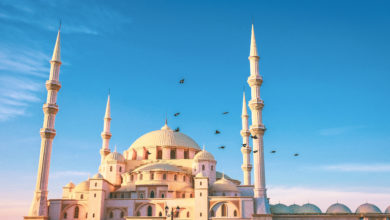The history of the world’s great mosques
Jama Masjid of Delhi
Alternative Titles: Jāmiʿ Masjid, Masjid-i Jahānnumā
Jama Masjid of Delhi, Jama Masjid also spelled Jāmiʿ Masjid, Jama Masjid of Delhi also called Masjid-i Jahānnumā, mosque in Old Delhi, India, constructed in 1650–56 by the Mughal emperor Shah Jahān, a noted patron of Islamic architecture whose most famous work is the Taj Mahal, in Agra.
Jama Masjid, now the second largest mosque on the Indian subcontinent, is also an impressive example of Mughal architecture.Jama Masjid is Delhi’s principal mosque, the place where the city’s Muslims traditionally gather for Friday communal prayer; Jama Masjid is Arabic for “Friday mosque.”
The mosque is near the Red Fort, yet another of Shah Jahān’s buildings. Jama Masjid and its courtyard stand on an outcropping more than 30 steps higher than the street, giving the mosque a commanding view of the surrounding area.
The longer name, Masjid-i Jahānnumā, translates to “world-reflecting mosque” or “world-displaying mosque.”The mosque was built by a crew of some 5,000 workers.
The principal construction material was red sandstone, but some white marble was also used.Jama Masjid is oriented toward the holy city of Mecca, Saudi Arabia, which lies to the west. An open courtyard facing the eastern gateway of the mosque building is at least 325 feet (99 metres) square and can accommodate 25,000 people.
The eastern gateway itself was originally reserved for royal use exclusively. Others used smaller gates on the north and south sides of the building. Two 130-foot (40-metre) minarets mark the northeast and southeast corners of the building. The largest interior space is the prayer hall, 90 × 200 feet (27.4 × 60.96 metres). Above the prayer hall’s entrances are calligraphic inscriptions in Persian. Three large marble domes rise from the prayer hall’s roof.
MIND-BLOWING FACTS ABOUT DELHI’S JAMA MASJID
Kids playing in Jama Masjid’s courtyard
Jama Masjid stands as one of the most remarkable structures in the Indian capital, and also has massive religious significance for the followers of Islam. If you have walked the lanes of Old Delhi, there is no way you have missed spotting it on the skyline. While Old Delhi is one of the most congested areas of the city, it has a charm that is unparalleled and draws in tourists from all over the world. Undeniably, Jama Masjid is the star attraction here. If you plan on visiting it soon, here are some facts that you might have not known.
The architecture
You would be surprised to know that this mosque’s architecture derives inspiration from Jain and Hindu methods, especially in the western portion of it. There is a huge hall in this wing of the structure and has motifs and patterns that are widely used in other religions, making it an inherently multi-cultural experience.
The meaning
While there are various theories about the meaning of Jama Masjid’s being, noted historians believe that Shah Jahan’s vision was to send the message of world unity. It was originally named as Masjid-i-Jahan-Numa, which translates to the majid that reflects the world. Believe it or not, but the sheer enormity of this structure would make you believe in the smallness of your being.
The cost
Delhi’s Jama Masjid was built at the behest of Mughal Emperor Shah Jahan between 1644 and 1656, and a mammoth 1 million rupees were spent on it back then. More than 5000 workers constructed it, working relentlessly for over a decade.
The inauguration
You would be surprised to know that an Imam from Uzbekistan inaugurated Jama Masjid, coming over all that distance some centuries back. Needless to mention, that must have been a journey of epical proportions.

